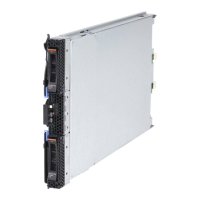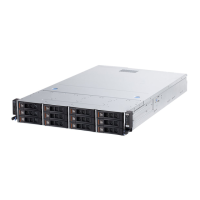With FlexNode processing, you can toggle between single partition mode and
stand-alone mode without having to modify the physical setup of the blade
servers. To toggle between modes, use the advanced management module Web
interface.
For example, assume that you have created a scalable blade complex and defined
that complex as a single partition through the advanced management module Web
interface:
v You can toggle the scalable blade complex to stand-alone mode through the Web
interface. In stand-alone mode, you can install a different operating system on
each blade server and run different applications on each blade server.
v You can then toggle the blade server complex back to a single partition and run
applications that take advantage to up to 4 processors and 32 DIMMs. The
operating system that is in use is the operating system of the primary blade
server.
v Later, you can toggle the complex back to stand-alone mode again to gain access
to the operating system on the secondary blade server.
Single partition mode considerations
The following considerations apply to the blade servers in a scalable blade
complex that operates as a single hardware partition:
v All UEFI settings (set through the Setup utility) should be the same on both
blade servers. If they are not, the settings that are defined for the primary blade
server replace the UEFI settings on the secondary server.
Note: When you upgrade the firmware for the blade servers operating in single
partition mode, you only have to upgrade the primary blade server. The
firmware on the secondary blade server is automatically updated. See “Using
the Setup utility” on page 72 for more information about the Setup utility.
v The primary blade server has access to the SSDs on the secondary blade server.
However, the SSDs on the primary blade server cannot be combined with the
SSDs on the secondary blade server to form a single RAID array. RAID arrays
can be formed only using the SSDs within a blade server.
v The primary blade server has access to any I/O expansion cards that are
installed in the secondary blade server. However, the I/O expansion cards in the
secondary blade server cannot be used for a Serial Over LAN connection.
v The primary blade server has access to any expansion blades that are installed
on the secondary blade server.
Important: An expansion blade installed on the secondary blade server cannot
be used for a Serial Over LAN connection.
v If you press the power button on one blade server, both blade servers in the
partition either power up or power down, depending on the state of the blade
servers when you press the power button.
14 IBM BladeCenter HX5 Type 7873, 7872, 1910, and 1909: Installation and User's Guide

